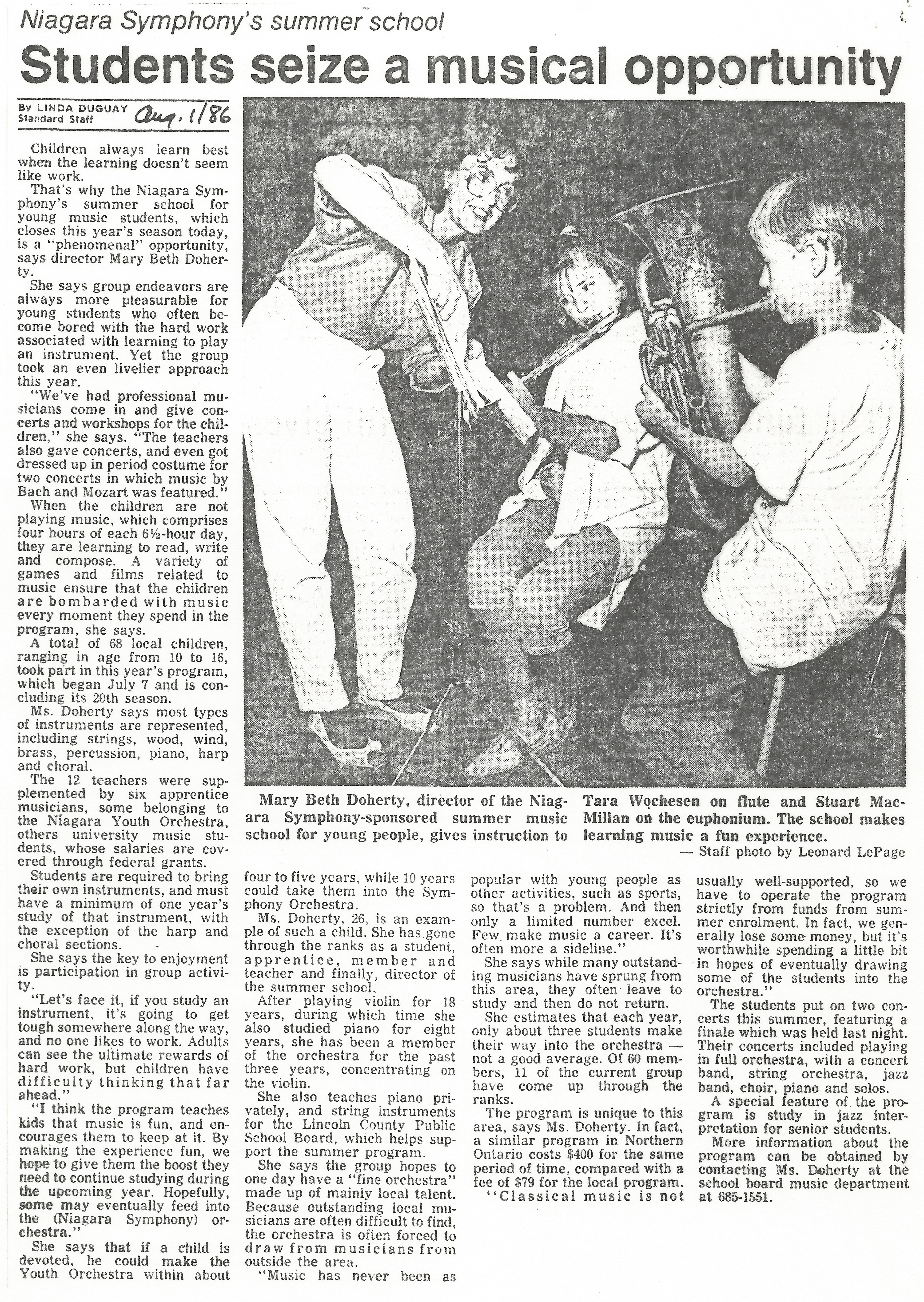Summer School 1986

Photographer: Leonard LePage for the Standard
Date: August 1, 1986
Article printed in the St. Catharines Standard
Transcript of article
Students seize a musical opportunity
Children always learn best when the learning doesn’t seem like work.
That’s why the Niagara Symphony’s summer school for young music students, which closes this year’s season today, is a “phenomenal” opportunity, says director Mary Beth Doherty.
She says group endeavours are always more pleasurable for young students who often become bored with the hard work associated with learning to play an instrument. Yet the group took an even livelier approach this year.
“We’ve had professional musicians come in and give concerts and workshops for the children,” she says. “The teachers also gave concerts, and even got dressed up in period costume for two concerts in which music by Bach and Mozart was featured.”
When the children are not playing music, which comprises four hours of each 6 ½ -hour day, they are learning to read, write and compose. A variety of games and films related to music ensure that the children are bombarded with music every moment they spend in the program, she says.
A total of 68 local children, ranging in age from 10 to 16, took part in this year’s program, which began July 7 and is concluding its 20th season.
Ms. Doherty says most types of instruments are represented, including strings, wood, wind, brass, percussion, piano, harp and choral.
The 12 teachers were supplemented by six apprentice musicians, some belonging to the Niagara Youth Orchestra, others university music students, whose salaries are covered through federal grants.
Students are required to bring their own instruments, and must have a minimum of one year’s study of that instrument, with the exception of the harp and choral sections.
She says the key to enjoyment is participation in group activity.
“Let’s face it, if you study and instrument, it’s going to get tough somewhere along the way, and no one likes work. Adults can see the ultimate rewards of hard work, but children have difficulty thinking that far ahead.”
“I think the program teaches kids that music is fun, and encourages them to keep at it. By making the experience fun, we hope to give them the boost they need to continue studying during the upcoming year. Hopefully, some may eventually feed into the (Niagara Symphony) orchestra.”
She says that if a child is devoted, he could make the Youth Orchestra within about four to five years, while 10 years could take them into the Symphony Orchestra.
Ms. Doherty, 26, is an example of such a child. She has gone through the ranks as a student, apprentice, member and teacher and finally, director of the summer school.
After playing violin for 18 years, during which time she also studied piano for eight years, she has been a member of the orchestra for the past three years, concentrating on the violin.
She also teaches piano privately, and string instruments for the Lincoln County Public School Board, which helps support the summer program.
She says the group hopes to one day have a “fine orchestra” made up of mainly local talent. Because outstanding local musicians are often difficult to find, the orchestra is often forced to draw from musicians from outside the area.
“Music has never been as popular with young people as other activities, such as sports, so that’s a problem. And then only a limited number excel. Few make music a career. It’s often more a sideline.”
She says while many outstanding musicians have sprung from this area, they often leave to study and then do not return.
She estimates that each year, only about three students make their way into the orchestra – not a good average. Of 60 members, 11 of the current group have come up through the ranks.
The program is unique to this area, says Ms. Doherty. In fact, a similar program in Northern Ontario costs $400 for the same period of time, compared with a fee of $79 for the local program.
“Classical music is not usually well-supported, so we have to operate the program strictly from funds from summer enrollment. In fact, we generally lose some money, but it’s worthwhile spending a little bit in hopes of eventually drawing some of the students into the orchestra.”
The students put on two concerts this summer, featuring a finale which was held last night. Their concerts included playing in full orchestra, with a concert band, string orchestra, jazz band, choir, piano and solos.
A special feature of the program is study in jazz interpretation for senior students.

